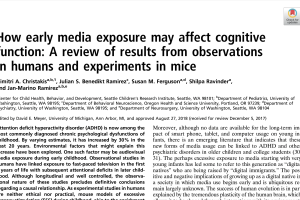Abstract
Attention deficit hyperactivity disorder (ADHD) is now among the most commonly diagnosed chronic psychological dysfunctions of childhood. By varying estimates, it has increased by 30% in the past 20 years. Environmental factors that might explain this increase have been explored. One such factor may be audiovisual media exposure during early childhood. Observational studies in humans have linked exposure to fast-paced television in the first 3 years of life with subsequent attentional deficits in later child- hood. Although longitudinal and well controlled, the observational nature of these studies precludes definitive conclusions regarding a causal relationship. As experimental studies in humans are neither ethical nor practical, mouse models of excessive sensory stimulation (ESS) during childhood, akin to the enrichment studies that have previously shown benefits of stimulation in rodents, have been developed. Experimental studies using this model have corroborated that ESS leads to cognitive and behavioral deficits, some of which may be potentially detrimental. Given the ubiquity of media during childhood, these findings in human- sand rodents perhaps have important implications for public health.
This article is part of a larger compilation of proceedings from “Digital Media and Developing Minds,” an interdisciplinary conference co-sponsored by Children and Screens and the National Academy of Sciences held in 2015. See a complete list of articles included in the proceedings.
